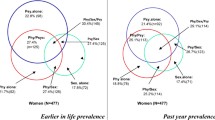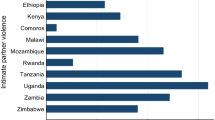Abstract
This paper explores if women’s empowerment is a protective factor against intimate partner violence (IPV) using a nationally representative, cross-sectional sample of 45,211 ever-married women in India. Descriptive statistics were used to examine women’s empowerment, and differences in individual-level and household-level characteristics among the sample. Logistic regression analyses were conducted to assess the contribution of the indicators of women’s empowerment in predicting past-year and lifetime physical and sexual IPV. Women who possessed a secondary education or higher, owned property, and had high intrahousehold decision-making power were less likely to experience IPV. Implications for practice and research are discussed.

Similar content being viewed by others
Availability of Data
The analysis was based on the datasets collected for the India Demographic and Health Survey. Information on the data and content can be assessed at http://www.dhsprogram.com/data/available-datasets.cfm.
References
Abramsky, T., Lees, S., Stöckl, H., Harvey, S., Kapinga, I., Ranganathan, M., Mshana, G., & Kapiga, S. (2019). Women’s income and risk of intimate partner violence: secondary findings from the MAISHA cluster randomized trial in North-Western Tanzania. BMC Public Health, 19(1), 1108.
Ackerson, L. K., Kawachi, I., Barbeau, E. M., & Subramanian, S. V. (2008). Effects of individual and proximate educational context on intimate partner violence: a population based study of women in India. American Journal of Public Health, 98(3), 507–514.
Arnold, F., Kishor, S., & Roy, T. K. (2002). Sex-selective abortions in India. Population and Development Review., 28(4), 759–785.
Bates, L. M., Schuler, S. R., Islam, F., & Islam, M. K. (2004). Socioeconomic factors and processes associated with domestic violence in rural Bangladesh. International Family Planning Perspectives, 190–199.
Batra, R., & Reio Jr., T. G. (2016). Gender inequality issues in India. Advances in Developing Human Resources, 18(1), 88–101.
Bender, A. K. (2017). Ethics, methods, and measures in intimate partner violence research: the current state of the field. Violence Against Women, 23(11), 1382–1413.
Bhattacharyya, M., Bedi, A. S., & Chhachhi, A. (2011). Marital violence and women’s employment and property status: evidence from north Indian villages. WorldDevelopment, 39(9), 1676–1689.
Bhengra, R., Bijoy, C. R., & Luithui, S. (1999). The Adivasis of India. Minority Rights Group.
Bullock, C. F. (2007). Framing domestic violence fatalities: coverage by Utah newspapers. Women's Studies in Communication, 30(1), 34–63.
Bullock, C. F., & Cubert, J. (2002). Coverage of domestic violence fatalities by newspapers in Washington state. Journal of Interpersonal Violence, 17(5), 475–499.
Campbell, J. C. (2002). Health consequences of intimate partner violence. The Lancet, 359(9314), 1331–1336.
Carlyle, K. E., Slater, M. D., & Chakroff, J. L. (2008). Newspaper coverage of intimate partner violence: skewing representations of risk. Journal of Communication, 58(1), 168–186.
Chandra, P. S., Satyanarayana, V. A., & Carey, M. P. (2009). Women reporting intimate partner violence in India: associations with PTSD and depressive symptoms. Archives of Women's Mental Health, 12(4), 203–209.
Dalal, K. (2011). Does economic empowerment protect women from intimate partner violence? Journal of Injury and Violence Research, 3(1), 35–44.
DeKeseredy, W. S., & Schwartz, M. D. (1998). Measuring the extent of woman abuse in intimate heterosexual relationships: a critique of the conflict tactics scales. US Department of Justice Violence Against Women Grants Office Electronic Resources.
Dommaraju, P. (2009). Marriage Age and Fertility Dynamics in India. Asia Research Institute, National University of Singapore.
Dyson, T., & Moore, M. (1983). On kinship structure, female autonomy, and demographic behavior in India. Population and Development Review, 35–60.
ECOSOC, U. (2019). Special edition: progress towards the sustainable development goals report of the secretary-general. Advanced Unedited Version. New York (US): United Nations.
Goddard, C., & Gillinder, B. (2010). Intimate partner violence and child abuse: a child centered perspective. Child Abuse Review, 19(5), 5–20. https://doi.org/10.1002/car.1084.
Gundappa, A., & Rathod, P. B. (2012). Violence against women in India: preventive measures. Indian Streams Research Journal, 2(4), 1–4.
Heise, L. L., & Kotsadam, A. (2015). Cross-national and multilevel correlates of partner violence: an analysis of data from population-based surveys. The Lancet Global Health, 3(6), e332–e340.
Huecker, M. R., & Smock, W. (2019). Domestic violence. StatPearls. Treasure Island International Institute for Population Sciences (IIPS) and ICF. (2017). National Family Health Survey (NFHS-4), 2015–16: India. Mumbai: IIPS.
International Center for Research on Women (ICRW). (2007). New insight on preventing child marriage: a global analysis of factors and programs. Washington, DC: ICRW.
International Institute for Population Sciences (IIPS) and ICF. (2017). National Family Health Survey (NFHS-4), 2015–16: India. Mumbai: IIPS.
Jejeebhoy, S. J. (1998). Associations between wife-beating and fetal and infant death: impressions from a survey in rural India. Studies in Family Planning, 29(3), 300–308.
Kabeer, N. (1999). Resources, agency, achievements: reflections on the measurement of women's empowerment. Development and Change, 30(3), 435–464.
Kabeer, N. (2001). Conflicts over credit: re-evaluating the empowerment potential of loans to women in rural Bangladesh. World Development, 29(1), 63–84.
Kabeer, N., & Subrahmanian, R. (Eds.). (1999). Institutions, relations, and outcomes: a framework and case studies for gender-aware planning. Zubaan.
Kim, J. C., Watts, C. H., Hargreaves, J. R., Ndhlovu, L. X., Phetla, G., Morison, L. A., Busza, J., Porter, J. D. H., & Pronyk, P. (2007). Understanding the impact of a microfinance-based intervention on women’s empowerment and the reduction of intimate partner violence in South Africa. American Journal of Public Health, 97(10), 1794–1802.
Kimuna, S. R., Djamba, Y. K., Ciciurkaite, G., & Cherukuri, S. (2013). Domestic violence in India: Insights from the 2005-2006 national family health survey. Journal of Interpersonal Violence, 28(4), 773–807.
Koenig, M. A. (2003). The impact of quality of care on contraceptive use: evidence from longitudinal data from rural Bangladesh.
Kolar, K. R., & Davey, D. (2007). Silent victims: children exposed to family violence. The Journal of School Nursing, 23(2), 86–91.
Koski, A., & Heymann, J. (2017). Thirty-year trends in the prevalence and severity of female genital mutilation: a comparison of 22 countries. BMJ Glob Health, 2(4), bmjgh-2017.
Mathur, S., Greene, M., & Malhotra, A. (2003). Too young to wed. The lives, rights, and health of young married girls. Washington, DC: International Center for Research on Women.
Panda, P., & Agarwal, B. (2005). Marital violence, human development and women’s property status in India. World Development, 33(5), 823–850.
Pandey, A. (2012). Communal violence in contemporary India, political parties and civic life- a case study of Gujarat.
Pandey, S., Karki, Y. B., Murugan, V., & Mathur, A. (2017). Mothers’ risk for experiencing neonatal and under-five child deaths in Nepal: the role of empowerment. Global Social Welfare, 4(3), 105–115.
Peterman, A., Pereira, A., Bleck, J., Palermo, T. M., & Yount, K. M. (2017). Women’s individual asset ownership and experience of intimate partner violence: evidence from 28 international surveys. American Journal of Public Health, 107(5), 747–755.
Sagun, S., Santhya, K. G., & Jejeebhoy, S. J. (2013). Determinants of marital violence. Economic and Political Weekly, 47, 41–45.
Sawant, S. T. (2016). Place of the woman in Indian society: a brief review. Journal of Human Social Sciences, 21, 21–25.
Scheufele, D. A. (2000). Agenda-setting, priming, and framing revisited: another look at cognitive effects of political communication. Mass Communication & Society, 3(2–3), 297–316.
Shidhaye, R., & Patel, V. (2010). Association of socio-economic, gender and health factors with common mental disorders in women: a population-based study of 5703 married rural women in India. International Journal of Epidemiology, 39(6), 1510–1521.
Speizer, I. S., & Pearson, E. (2011). Association between early marriage and intimate partner violence in India: a focus on youth from Bihar and Rajasthan. Journal of Interpersonal Violence, 26(10), 1963–1981.
UNIFEM, O. (2005). Securing the peace: guiding the international community towards women’s effective participation throughout peace processes.
United Nations. Dept. for Economic, Social Information, & Policy Analysis. (1995). Population and development: programme of action adopted at the International Conference on Population and Development, Cairo, 5-13 September 1994 (Vol. 1). New York: United Nations, Department for Economic and Social Information and Policy Analysis.
United Nations Development Programme (UNDP). (2005). “Looking for equality: a gender review of National MDG Reports.”
Varma, D., Chandra, P. S., Thomas, T., & Carey, M. P. (2007). Intimate partner violence and sexual coercion among pregnant women in India: relationship with depression and post-traumatic stress disorder. Journal of Affective Disorders, 102(1-3), 227–235.
Vyas, S., & Watts, C. (2009). How does economic empowerment affect women’s risk of intimate partner violence in low and middle income countries? A systematic review of published evidence. Journal of International Development: The Journal of the Development Studies Association, 21(5), 577–602.
Wagner, J., Jones, S., Tsaroucha, A., & Cumbers, H. (2019). Intergenerational transmission of domestic violence: practitioners’ perceptions and experiences of working with adult victims and perpetrators in the UK. Child Abuse Review, 28(1), 39–51.
Weber, A. M., Cislaghi, B., Meausoone, V., Abdalla, S., Mejía-Guevara, I., Loftus, P., et al. (2019). Gender norms and health: insights from global survey data. The Lancet, 393(10189), 2455–2468.
World Health Organization. (2012). Understanding and addressing violence against women: intimate partner violence. Geneva: World Health Organization.
World Health Organization. (2013). Responding to intimate partner violence and sexual violence against women: WHO clinical and policy guidelines. World Health Organization.
World Health Organization. (2017). Consolidated guideline on sexual and reproductive health and rights of women living with HIV. World Health Organization.
Author information
Authors and Affiliations
Corresponding author
Ethics declarations
Conflict of Interest
The author declares that there is no conflict of interest.
Ethics Approval and Consent to Participate
NFHS surveys in India were reviewed and approved by the IIPS Institutional Review Board and the ICF Institutional Review Board. The protocol was also reviewed by the U.S. Centers for Disease Control and Prevention (CDC). We used de-identified publicly available dataset from DHS website for this analysis. Therefore, no separate ethical approval was required for this analysis. In NFHS-4, the interviewers pursued informed consent from the women before interviews. Privacy and confidentiality were ensured during interviews by trained female interviewers who received special training to administer the domestic violence module. Permission was obtained from Measure DHS to use the data for further analysis.
Additional information
Publisher’s Note
Springer Nature remains neutral with regard to jurisdictional claims in published maps and institutional affiliations.
Rights and permissions
About this article
Cite this article
Murugan, V., Khoo, YM. & Termos, M. Intimate Partner Violence Against Women in India: Is Empowerment a Protective Factor?. Glob Soc Welf 8, 199–211 (2021). https://doi.org/10.1007/s40609-020-00186-0
Published:
Issue Date:
DOI: https://doi.org/10.1007/s40609-020-00186-0




